Historic Polegreen Church (Hanover Meeting House)
Introduction
Text-to-speech Audio
Images
Historic Polegreen Church, also known as 'The Ghost Church'
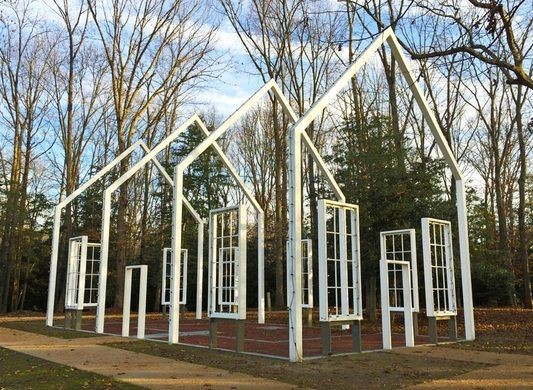
Photograph from the inside of the Historic Polegreen Church
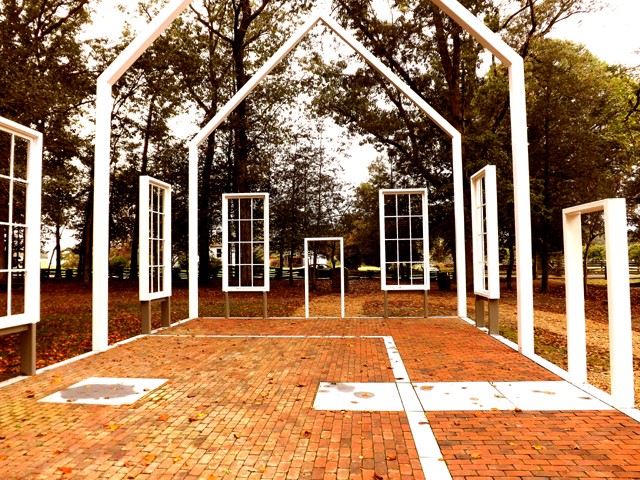
Sketch of the interior of Polegreen Church by Lieutenant Thomas M. Farrell. The drawings done by Farrell are dated 1862- two years before the church was destroyed.
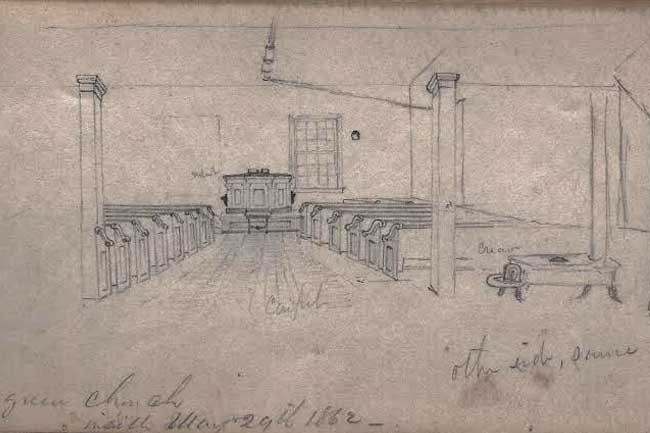
Exterior view sketch of Polegreen Church by Lieutenant Thomas M. Farrell. The drawings done by Farrell are dated 1862- two years before the church was destroyed.
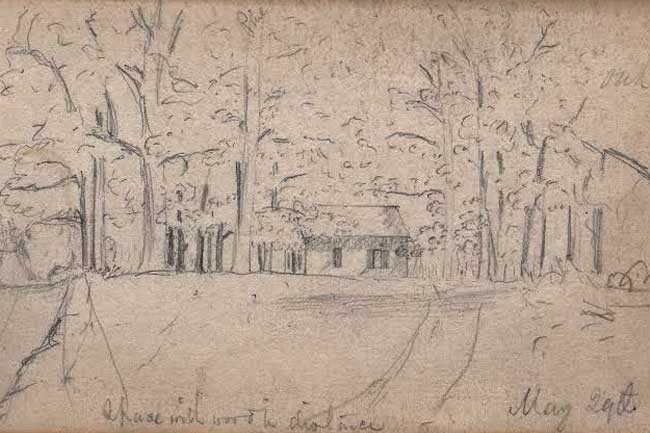
Reverend Samuel Davies (1723-1761)
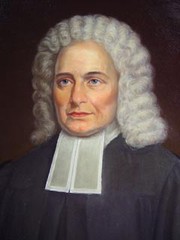
Historical marker for the church

Stone monument marker for the Historic Polegreen Church
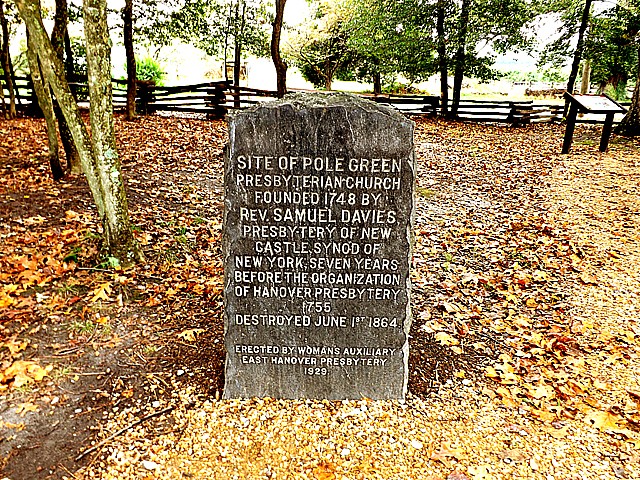
Backstory and Context
Text-to-speech Audio
Throughout the 17th century, the Anglican Church was the only recognized religion in the colony of Virginia. As a state-sponsored religion, Anglican churches were constructed and maintained by the colonial government. The clergymen who led these churches were also paid using money derived from taxes and were therefore beholden to the colonial government. As was the case in England at the time, attendance to an Anglican church was mandatory and skipping services often resulted in fines.
Beginning in the 1730's, however, a religious revival movement called the "Great Awakening" grew quickly in Virginia and the surrounding colonies. First mobilized by the preachings and writings of an energetic evangelist named George Whitefield, the "Great Awakening" called upon individuals to find personal meaning in religious doctrine and represented a direct challenge to the status quo of state-sponsored religion. After Whitefield preached in Williamsburg in 1739, his sermon was printed and spread like wildfire throughout Virginia. Inspired by Whitefield’s message, Samuel Morris- a brick mason from Hanover County- stopped attending the local church and began hosting meetings to read scripture. Morris was fined multiple times by a local judge before being ordered to appear alongside other dissenters before a judge in Williamsburg in 1743. There, they convinced the court to allow them to build four “reading houses”- three in Hanover and one in Henrico- where they could practice their beliefs quietly.
The reading house built on Samuel Morris’s land that year was dubbed “Polegreen Church” after the former landowner, George Polegreen. In July of 1743, the first sermon was delivered at Polegreen Church by William "One Eye" Robinson, a traveling Presbyterian preacher. Robinson collected an offering there for his protegee, a young man named Samuel Davies who was studying to join the ministry. After completing his studies, a 23-year-old Davies travelled to meet the Hanover dissenters at Polegreen four years later to thank them for their gift. Upon petition by the dissenters, Davies then went to Williamsburg in order to acquire a preaching license. With this license, Davies became the first non-Anglican minister licensed to preach in Virginia. He preached in Hanover County with remarkable success, presiding over 14 congregations before he left Virginia in 1759. During this time, a young Patrick Henry worshipped at Polegreen Church with his mother, who was one of the original Hanover dissenters. Later in his life, Henry would credit Davies with “teaching me what an orator should be.”
The Polegreen Church stood as a testament to religious freedom in Virginia until May of 1864 when Civil War General Ulysses S. Grant attempted to take the City of Richmond by breaking through General Robert E. Lee’s troops stationed along Totopotomoy Creek. In an effort to dispel Union sharpshooters who had occupied Polegreen Church, Confederate artillery fired upon the building, burning it down entirely. The Confederate soldier who fired the shot that destroyed the church, a Richmond Howitzers gunner named William S. White, recorded the event in his diary. In the entry, White remarks that, ironically, his own father had been baptized in Polegreen Church years prior.
Due to a lack of resources during the war, the congregation which had worshipped at Polegreen was not able to rebuild the church. The site sat empty until 1929 when the Woman’s Auxiliary East Hanover Presbytery placed a stone monument marker commemorating the historic church. This was the only marking of the church’s existence until 1990, when the Hanover Presbytery- founded in Polegreen Church in 1755- oversaw the forming of a non-profit foundation dedicated to preserving the location. Thanks to the efforts of the Historic Polegreen Church Foundation, the site was added to the National Register of Historic Places that same year.
In August of 2000, construction of an interpretive monument to honor the former Historic Polegreen Church began. The monument, consisting solely of large white steel beams, was designed by renowned architect Carlton Abbott to mirror the exact dimensions of the once-standing church. This was made possible thanks to sketches of the building drawn by an Union soldier almost exactly two years before the church was shelled. The project was completed in June of the following year. In the years since, it became known as 'The Ghost Church' and has gained popularity as an outdoors wedding venue. In 2015, musician Jason Mraz married his longtime girlfriend at Historic Polegreen Church. Today, the monument is open to the public 24/7.
Sources
Bluford, Robert. America's First Freedom Inspired in Hanover, Richmond Times-Dispatch. May 20th 2007. Accessed November 24th 2020. https://richmond.com/news/americas-first-freedom-inspired-in-hanover/article_950a52fd-2f73-5578-b02a-8a4db6613151.html.
Daniel & Company, INC.. Historic Polegreen Church - Interpretive Church Structure, Daniel & Company, INC. Contractors . Accessed November 24th 2020. http://www.danielco.net/portfolio/details/historic_polegreen_church_interpretive_church_structure.
Historic Polegreen Church Foundation. The Polegreen Story, Historic Polegreen Church Foundation. Accessed November 12th 2020. https://www.historicpolegreen.org/story.php.
Road to Revolution Heritage Trail. Polegreen Church, Road to Revolution Heritage Trail. Accessed November 24th 2020. https://roadtorevolution.com/polegreen-church/.
Roberts, Daniel. Polegreen Church: The Beginning, Historic Polegreen. Accessed November 24th 2020. https://www.historicpolegreen.org/media/guide-by-cell-mp3s/02.mp3.
https://www.atlasobscura.com/places/ghost-church-at-polegreen
http://www.churchesofvirginia.org/pole_green_church/index.htm
https://www.historicpolegreen.org/story.php
https://www.historicpolegreen.org/story.php
https://www.historicpolegreen.org/story.php
http://www.churchesofvirginia.org/pole_green_church/index.htm
http://www.churchesofvirginia.org/pole_green_church/index.htm
